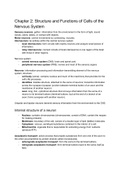Chapter 2: Structure and Functions of Cells of the
Nervous System
Sensory neurons: gather information from the environment in the form of light, sound
waves, odors, tastes, or contact with objects.
Motor neurons: control movements by contracting muscles.
Interneurons: lie entirely within the central nervous system.
- local interneurons: form circuits with nearby neurons and analyze small pieces of
information.
- relay interneurons: connect circuits of local interneurons in one region of the brain
with those in other regions.
Nervous system:
- central nervous system (CNS): brain and spinal cord
- peripheral nervous system (PNS): nerves and most of the sensory organs
Neurons: information-processing and information-transmitting element of the nervous
system, structure:
- cell body (soma): contains nucleus and much of the machinery that provides for the
cell’s life processes.
- dendrites: treelike structure, attached to the soma of neurons; transmits information
across the synapse (synapse: junction between terminal button of an axon and the
membrane of another neuron)
- axon: long, thin, cylindrical structure that conveys information from the soma of a
neuron to its terminal buttons (terminal buttons: bud at the end of a branch of an
axon; forms synapses with another neuron).
Unipolar and bipolar neurons transmit sensory information from the environment to the CNS.
Internal structure of a neuron
- Nucleus: contains chromosomes (chromosomes: consist of DNA, contain the recipes
for making proteins)
- Membrane: boundary of the cell, consist of a double layer of lipid (fatlike) molecules.
- Cytoplasm: viscous, semiliquid substance contained in the interior of a cell.
- Mitochondria: organelle that is responsible for extracting energy from nutrients
(produce ATP).
Axoplasmic transport: active process that propels substances from one end of the axon to
the other (accomplished by protein strands called microtubules).
- anterograde axoplasmic transport: from the soma to the terminal buttons.
- retrograde axoplasmic transport: from terminal buttons back to the soma (half as
fast).
,Supporting cells of the CNS
Glia (85% of cells in the brain): surround neurons and hold them in place, controlling their
supply of nutrients and some of the chemicals they need to exchange messages with other
neurons, destroying/removing neurons that are killed (=phagocytosis). Three types:
- astrocytes: provides physical support to neurons and clean up debris within the
brain, provide chemicals and nourishment to neurons, form scar tissue.
- oligodendrocytes: support to axons and to produce myelin sheath (insulates most
axons from one another, gap between the sheaths segments is called node of
Ranvier).
- microglia: act as phagocytes, protecting the brain from invading microorganisms,
responsible for the inflammatory reaction in response to brain damage.
Schwann cell: in the peripheral nervous system, wrapped around a myelinated axon,
providing one segment of its myelin sheath, difference with oligodendrocytes:
- in the PNS one Schwann cell provides myelin for only one axon.
- chemical composition of the myelin protein is different.
Blood-brain barrier
Blood-brain barrier: semipermeable barrier between the blood and the brain produced by
the cells in the wall of the brain’s capillaries.
- makes it easier to regulate the composition of the extracellular fluid
- food contains chemicals, with the barrier these chemicals won’t reach the brain
- area postrema (part of the brains that controls vomiting): here the blood-brain barrier
is much weaker, so vomiting can happen when you get poisoned.
Communication within a neuron
Membrane potential: difference in electrical potential inside and outside the cell.
Resting potential: membrane potential when the neuron is not being altered.
- negative inside and positive charge? → depolarization (reduction, towards zero)
- hyperpolarized: more polarized than resting potential.
- action potential: brief electrical impulse that provides the basis for conduction of
information along an axon.
- threshold of excitation: value of the membrane potential that must be
reached to produce an action potential.
- brief increase in the permeability of the membrane to Na+ (rush into the cell),
followed by a transient increase in the permeability of the membrane to K+
(rush out of the cell).
Diffusion: process whereby molecules distribute themselves evenly throughout the medium
in which they are dissolved.
Electrolyte: aqueous solution of a material that ionizes, namely a soluble, acid, base, or
salt.
Ions: cations (positive charge), anions (negative charge), cations attract anions.
- electrostatic pressure: the attractive force between atomic particles with opposite
signs, or the repulsive force between atomic particles charged with the same sign.
,In the intracellular and extracellular fluid are different ions, important ones:
- organic ions (A–), only in intracellular fluid!
- chloride ions (Cl–)
- sodium ions (Na+)
- potassium ions (K+).
Sodium-potassium transporters: protein found in the membrane of all cells, that extrudes
sodium (Na+) ions from and transports potassium(K+) ions into the cell, using ATP!
Voltage-dependent potassium channels are less sensitive than voltage-dependent sodium
channels (therefore they require greater level of depolarization before they open).
All-or-none law: action potential either occurs or does not occur.
, Saltatory conduction: conduction of action potentials by myelinated axons. Actions
potential appears to jump from one node of Ranvier to the next
Communication between neurons
Postsynaptic potentials: brief depolarizations or hyperpolarizations, increase or decrease
the rate of firing of the axon of the postsynaptic neuron.
- reuptake: reentry of neurotransmitter back to its membrane, thus terminating the
postsynaptic potential.
- enzymatic deactivation: destruction of a neurotransmitter by an enzyme after its
release.
Binding site: location on a receptor protein to which ligand binds.
- neurotransmitters are natural ligand; produced and released by neurons. Artificial
ligands can be produced in the laboratory.
Axodendritic synapses occur on the smooth surface of a dendrite or on dendritic spines
(=small protrusions).
Axosomatic synapses occur in somatic membrane
Axoaxonic synapses consist of synapses between two terminal buttons.
- Presynaptic facilitation: increase in the release of neurotransmitters due to activity
axoaxonic synapse.
- Presynaptic inhibition: decrease in the release of neurotransmitters due to activity
in the axoaxonic synapse.
Postsynaptic membrane: receives the message, part of the dendrite.
Synaptic cleft: space between presynaptic membrane and the postsynaptic membrane.
Synaptic vesicles: small, hollow, round structure found in terminal buttons; contains
molecules of a neurotransmitter.
Ionotropic receptor: contains a binding site for a neurotransmitter and an ion channel that
opens when a molecule of the neurotransmitter attaches to the binding site.
Metabotropic receptor: contains a binding site for a neurotransmitter; activates an enzyme
that begins a series of events that opens an ion channel elsewhere in the cell’s membrane
G protein: protein coupled to a metabotropic receptor; conveys messages to other
molecules when a ligand binds with and activates the receptor.
Second messenger: chemical produced when a G protein activates an enzyme; carries a
signal that results in the opening of the ion channel or causes other events to occur in the
cell.
Excitatory postsynaptic potential (EPSP): excitatory/depolarization of the postsynaptic
membrane of a synapse caused by the liberation of a neurotransmitter (e.g. when sodium,
Na+, channels open sodium comes into the membrane).
- depolarizing = excitatory (e.g. by neurotransmitter glutamate)
Inhibitory postsynaptic potential (IPSP): inhibitory/hyperpolarization of the postsynaptic
membrane of a synapse caused by the liberation of a neurotransmitter (e.g. when
potassium, K+, channels open potassium comes out of the membrane).






